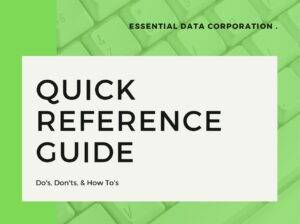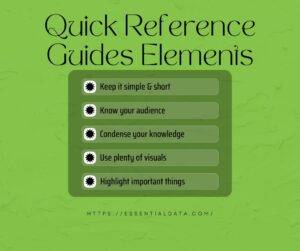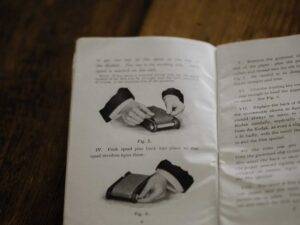
In life, we face problems that we cannot solve with just our knowledge alone. It could be putting together a chair, learning how to fix a leak, or even how to learn a new language. Without the help of some outside source, whether it be man or machine, there are many things we cannot accomplish. The world we live in wants faster methods that not only teach in full but get to the main point. In the business world, you will have customers who will be unable to understand what you are selling them and want written explanations. There are a set of papers that can illustrate, demonstrate, and communicate topics in a simplistic manner, commonly known as a “quick reference guide”.
The Elements of a Great Quick Reference Guide
A quick reference guide is a form of documentation that gives instructions on how to explain or use a product. They can come in one or two-page formats and provide either detailed or simple explanations depending on the merchandise. This allows users to grasp the concepts and have them readily available when they need help. In doing so, you grant the customer the tools for success and develop a closer relationship with the company. The formation and development of a quick reference guide are two of the most important tasks you need to remember. However, you might be wondering, what are the elements of a great quick reference guide? Listed below, here are the most important things to remember when creating a quick reference guide.

- Keep it simple & short: When writing a guide, you don’t want to clarify concepts with long-winded explanations. Some people don’t even want to read long paragraphs filled with complicated instructions. Make sure that people will want to read your guide by compressing your information into short and simple sentences. Write said sentences in a more passive voice to showcase formality among your customers or workers.
- Know your audience: Your audience is the key to an outstanding progression for a company. If you are writing a reference guide for teenagers, you need to use words and phrases that teenagers would know. If you are writing for a tech company, then the usage of technical terms and visual maps will help in explaining your topics. Once you know whom you are writing for, it becomes clear how to format your guides.
- Condense your knowledge: There’s so much you want to write out and much you want to inform your audience. In doing so, you cannot say everything you want and expect your customers to continue reading your guide with all that filler. Cut down your content and focus on the main points you want to speak about. Try thinking of your main topic, and three main points of discussion, and then finalize your conclusion. Slim down whatever you feel is running too long and add on if you can.
- Use plenty of visuals: A picture can speak a thousand words and illustrate a thousand concepts. A guide uses a basic layout that can be enhanced with visual aids. With the addition of pictures, you can paraphrase your words using graphs, charts, and other pictures to pad out the paper. In your reference guide, make sure to employ these pictures as a way to catch the eye of the customers and readers.
- Highlight important things: This may sound silly, but highlighting important words and terminology is quite useful. Like how one would a textbook or article, the use of highlighting allows the customers to understand what terms and words are crucial. A color such as yellow is eye-catching and screams importance as people tend to notice brighter colors over darker ones. Highlight only relevant data and sentences that your core audience needs to know and what you want them to know.
How To Write A Good Quick Reference Guide

A reference guide is a template that can be modified to shape a couple of pages worth of content. Once you’ve figured out how to add pictures, condense your information, and highlight the important details, how do you write a good quick reference guide?
Firstly, you must make sure that your guide is no longer than two pages. Keeping it short allows your customers to not get overwhelmed by too much information and keeps it concise. Next, make sure that the information is detailed enough that your customers don’t have to find another manual or go online to look up more. Don’t write just to fill out the two pages with utter nonsense, but write to teach someone something new. In doing so, you must never forget your visual aids like screenshots, designs, logos, and other things that catch the eye. Make sure that when you place your data and visuals down that you do them in sequential order. Don’t let your graphics not match up with the paragraph you put them over. Finally, make sure that what you’ve written down is accurate. A customer doesn’t want to read something that has many errors.
If you would like more information or examples of reference guides, check out these websites for templates. Scribe has some templates that are free to use and allow you to insert your pictures for your guide. Idratherbewriting also gives tips on how to format your guide and the best-looking templates for you to use. Try out these sites for ideas and tips for the formation of your quick reference guide. Once you start learning how to format and detail your guides, the easier it will become for you in the future.
Examples of Quick Reference Guides
Quick reference guides are designed to provide quick and easy access to important information, procedures, or steps. They are perfectly detailed and can be used for a variety of different mediums. Here are some examples of quick reference guides:
- Keyboard shortcuts: A quick reference guide for keyboard shortcuts can be a handy tool for employees who want to increase their productivity. It can include a list of common keyboard shortcuts for different programs or applications, such as Microsoft Word, Excel, or PowerPoint.
- Troubleshooting guide: A quick reference guide for troubleshooting common problems can be a valuable tool for technical support teams or help desk staff. It can include a list of common issues and steps to resolve them, as well as contact information for technical support.
- Safety procedures: A quick reference guide for safety procedures can help employees stay safe on the job. It can include a list of safety procedures, such as how to handle hazardous materials, how to respond to emergencies, and how to use safety equipment.
- Installation guide: A quick reference guide for installation procedures can be useful for IT staff or employees who need to install new software or hardware. It can include step-by-step instructions for the installation process, as well as troubleshooting tips for common issues.
- Product guides: A quick reference guide for products can be useful for sales teams or customer service representatives. It can include information about the features and benefits of a product, as well as tips for using it effectively.
Overall, quick reference guides are a versatile tool that can be used in a variety of industries and settings to provide quick and easy access to important information.
How Essential Data Corporation Can Help You
Quick reference guides are an essential tool that technical writers can create to help users access important information quickly and easily. Technical writers will first identify the most important information that must be included in the quick reference guide. This could include frequently used procedures, commands, or troubleshooting steps. Once the key information has been identified, writers will organize it in a logical and easy-to-follow format. This could include organizing it in a step-by-step format or grouping information by topic.
Technical writers will use clear and concise language that is easy for users to understand. Typically, they will avoid using technical jargon or complex language that could confuse or frustrate users. Technical writers are highly skilled in simplifying complex and technical language for the general public.
Visual aids such as screenshots, diagrams, or icons are employed to help users quickly understand the information in the guide. Technical writers consider using visual aids to supplement the text in the guide. Before finalizing the quick reference guide, technical writers test it with users to ensure that it is easy to use and effective. User feedback can help identify any areas that need improvement and determine if the guide meets the needs of the target audience.
No matter the industry, a technical writer can provide an excellent quick reference guide for your company. Whether you need a single technical writer for a brief project or a team of consultants to produce a complete line of documentation, the quality of our work is guaranteed for you. Our clients work closely with an Engagement Manager from one of our 30 local offices for the entire length of your project at no additional cost. Contact us at (800) 221-0093 or [email protected] to get started.
Written by Cecelia Lupton
